Manufacturing

Manufacturing is the value added production of merchandise for use or sale using labour and machines, tools, chemical and biological processing, or formulation. The term may refer to a range of human activity, from handicraft to high tech, but is most commonly applied to industrial production, in which raw materials are transformed into finished goods on a large scale. Such finished goods may be sold to other manufacturers for the production of other, more complex products, such as aircraft, household appliances or automobiles, or sold to wholesalers, who in turn sell them to retailers, who then sell them to end users and consumers.
Manufacturing or manufacturing process are the steps through which raw materials are transformed into a final product. The manufacturing process begins with the creation of the materials from which the design is made. These materials are then modified through manufacturing processes to become the required part.
Manufacturing takes turns under all types of economic systems. In a free market economy, manufacturing is usually directed toward the mass production of products for sale to consumers at a profit. In a collectivist economy, manufacturing is more frequently directed by the state to supply a centrally planned economy. In mixed market economies, manufacturing occurs under some degree of government regulation.
Modern manufacturing includes all intermediate processes required for the production and integration of a product's components. Some industries, such as semiconductor and steel manufacturers use the term fabrication instead.
The manufacturing sector is closely connected with engineering and industrial design. Examples of major manufacturers in North America include General Motors Corporation, General Electric, Procter & Gamble, General Dynamics, Boeing, Pfizer, and Precision Castparts. Examples in Europe include Volkswagen Group, Siemens, and Michelin. Examples in Asia include Sony, Huawei, Lenovo, Toyota, Samsung, and Bridgestone.
History and development
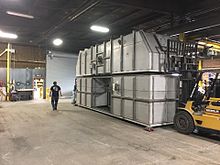
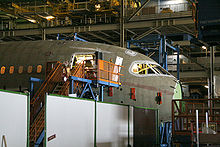
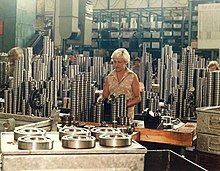
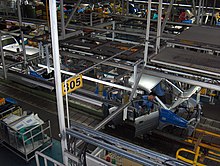
- In its earliest form, manufacturing was usually carried out by a single skilled artisan with assistants. Training was by apprenticeship. In much of the pre-industrial world, the guild system protected the privileges and trade secrets of urban artisans.
- Before the Industrial Revolution, most manufacturing occurred in rural areas, where household-based manufacturing served as a supplemental subsistence strategy to agriculture (and continues to do so in places). Entrepreneurs organized a number of manufacturing households into a single enterprise through the putting-out system.
- Toll manufacturing is an arrangement whereby a first firm with specialized equipment processes raw materials or semi-finished goods for a second firm.
Manufacturing systems: changes in methods of manufacturing
- Agile manufacturing
- American system of manufacturing
- British factory system of manufacturing
- Craft or guild system
- Fabrication
- Flexible manufacturing
- Just-in-time manufacturing
- Lean manufacturing
- Mass customization (2000s) - 3D printing, design-your-own web sites for sneakers, fast fashion
- Mass production
- Ownership
- Packaging and labeling
- Prefabrication
- Putting-out system
- Rapid manufacturing
- Reconfigurable manufacturing system
- Soviet collectivism in manufacturing
Industrial policy
Economics of manufacturing
According to some economists, manufacturing is a wealth-producing sector of a country, whereas a service sector tends to be wealth-consuming.[1][2] Emerging technologies have provided some new growth in advanced manufacturing employment opportunities in the Manufacturing Belt in the United States. Manufacturing provides important material support for national infrastructure and for national defense.
On the other hand, most manufacturing may involve significant social and environmental costs. The clean-up costs of hazardous waste, for example, may outweigh the benefits of a product that creates it. Hazardous materials may expose workers to health risks. These costs are now well known and there is effort to address them by improving efficiency, reducing waste, using industrial symbiosis, and eliminating harmful chemicals.[3] The increased use of technologies such as 3D printing also offer the potential to reduce the environmental impact of producing finished goods through distributed manufacturing.[4]
The negative costs of manufacturing can also be addressed legally. Developed countries regulate manufacturing activity with labor laws and environmental laws. Across the globe, manufacturers can be subject to regulations and pollution taxes to offset the environmental costs of manufacturing activities. Labor unions and craft guilds have played a historic role in the negotiation of worker rights and wages. Environment laws and labor protections that are available in developed nations may not be available in the third world. Tort law and product liability impose additional costs on manufacturing. These are significant dynamics in the ongoing process, occurring over the last few decades, of manufacture-based industries relocating operations to "developing-world" economies where the costs of production are significantly lower than in "developed-world" economies.
Manufacturing and investment
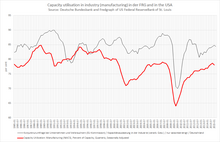
Surveys and analyses of trends and issues in manufacturing and investment around the world focus on such things as:
- The nature and sources of the considerable variations that occur cross-nationally in levels of manufacturing and wider industrial-economic growth;
- Competitiveness; and
- Attractiveness to foreign direct investors.
In addition to general overviews, researchers have examined the features and factors affecting particular key aspects of manufacturing development. They have compared production and investment in a range of Western and non-Western countries and presented case studies of growth and performance in important individual industries and market-economic sectors.[5][6]
On June 26, 2009, Jeff Immelt, the CEO of General Electric, called for the United States to increase its manufacturing base employment to 20% of the workforce, commenting that the U.S. has outsourced too much in some areas and can no longer rely on the financial sector and consumer spending to drive demand.[7] Further, while U.S. manufacturing performs well compared to the rest of the U.S. economy, research shows that it performs poorly compared to manufacturing in other high-wage countries.[8] A total of 3.2 million – one in six U.S. manufacturing jobs – have disappeared between 2000 and 2007.[9] In the UK, EEF the manufacturers organisation has led calls for the UK economy to be rebalanced to rely less on financial services and has actively promoted the manufacturing agenda.
Countries by manufacturing output using the most recent known data
List of top 20 manufacturing countries by total value of manufacturing in US dollars for its noted year according to Worldbank.[10][11]
| Rank | Country/Region | Millions of $US | Year |
|---|---|---|---|
| World | 12,578,627 | 2014 | |
| 1 | 3,713,300 | 2014 | |
| 2,566,070 | 2014 | ||
| 2 | 2,068,080 | 2014 | |
| 1,946,857 | 2014 | ||
| 3 | 850,902 | 2014 | |
| 4 | 787,503 | 2014 | |
| 5 | 389,582 | 2014 | |
| 6 | 321,721 | 2014 | |
| 7 | 296,611 | 2014 | |
| 8 | 283,664 | 2014 | |
| 9 | 282,675 | 2014 | |
| 10 | 248,481 | 2014 | |
| 11 | 218,799 | 2014 | |
| 12 | 216,773 | 2014 | |
| 13 | 186,744 | 2014 | |
| 14 | 166,594 | 2014 | |
| 15 | 162,074 | 2014 | |
| 16 | 128,881 | 2014 | |
| 17 | 126,365 | 2014 | |
| 18 | 112,214 | 2014 | |
| 19 | 95,683 | 2014 | |
| 20 | 93,461 | 2016 |
Manufacturing processes
Theories
Control
Outline of manufacturing
- List of largest manufacturing companies by revenue
- Industrial robot
- Manufacturing engineering
- Industrial engineering
- Advanced manufacturing
- Metal fabrication
- Microfabrication
- Optics fabrication
- Semiconductor device fabrication
- Biomanufacturing
- Mesoscale Manufacturing
- Cyber manufacturing
References
- ^ Friedman, David (2006). "No Light at the End of the Tunnel". Los Angeles Times. New America Foundation. Retrieved 2007-05-12.
- ^ Joseph, Keith (1976). "Monetarism Is Not Enough". Center for Policy Studies. Margaret Thatcher Foundation. Retrieved 2007-05-12.
- ^ For example, entire academic journals such as The Journal of Cleaner Production and The Journal of Industrial Ecology dedicated to reducing environmental impact of manufacturing.
- ^ Megan Kreiger and Joshua M. Pearce (2013). Environmental Life Cycle Analysis of Distributed 3-D Printing and Conventional Manufacturing of Polymer Products, ACS Sustainable Chemistry & Engineering, DOI: 10.1021/sc400093k Open access.
- ^ Manufacturing & Investment Around The World: An International Survey Of Factors Affecting Growth & Performance, ISR Publications/Google Books, revised second edition, 2002. ISBN 978-0-906321-25-6.
- ^ Research, Industrial Systems (2002-05-20). "Manufacturing and Investment Around the World: An International Survey of Factors Affecting Growth and Performance". ISBN 978-0-906321-25-6.
{{cite journal}}: Cite journal requires|journal=(help) - ^ Bailey, David and Soyoung Kim (June 26, 2009).GE's Immelt says U.S. economy needs industrial renewal. UK Guardian. Retrieved on June 28, 2009.
- ^ Brookings Institution, Why Does Manufacturing Matter? Which Manufacturing Matters?, February 2012
- ^ "Factory jobs: 3 million lost since 2000". USATODAY.com. April 20, 2007.
- ^ "Manufacturing, value added (current US$)". access in February 20, 2013.
- ^ "Manufacturing, value added (current US$) for EU and Eurozone". access in February 20, 2013.
Sources
- Kalpakjian, Serope; Steven Schmid (August 2005). Manufacturing, Engineering & Technology. Prentice Hall. pp. 22–36, 951–988. ISBN 0-13-148965-8.
External links
- Cato Institute article: Thriving in a Global Economy: The Truth about U.S. Manufacturing and Trade
- How Everyday Things Are Made: video presentations.Alina
- Time magazine article on American manufacturing's global effectiveness
- Grant Thornton IBR 2008 Manufacturing industry focus
- MFGWatch - Quarterly Survey of North American Manufacturers
- EEF, the manufacturers' organisation - industry group representing uk manufacturers
- Industry Today - Industrial and Manufacturing Methodologies
- Enabling the Digital Thread for Smart Manufacturing
